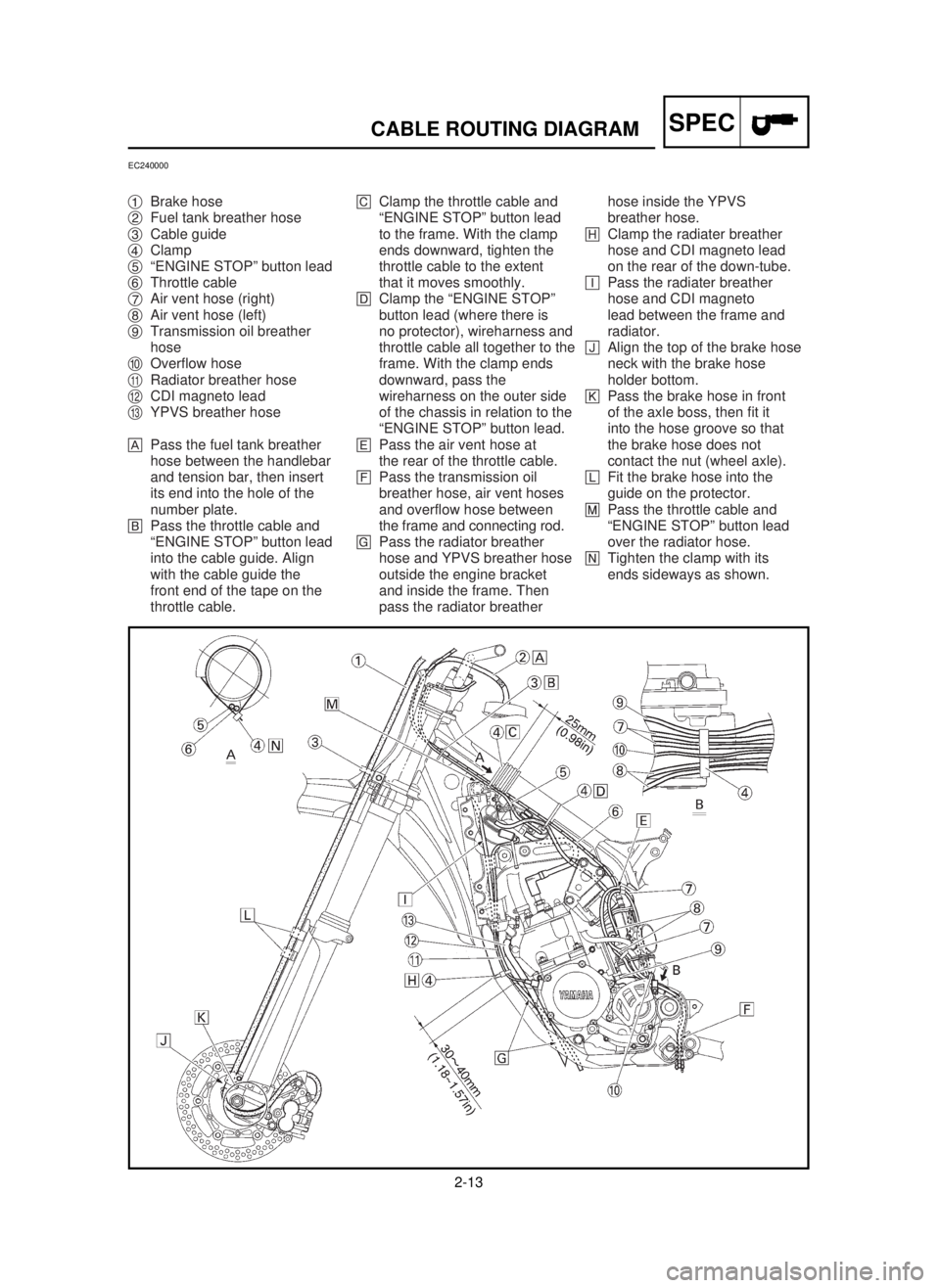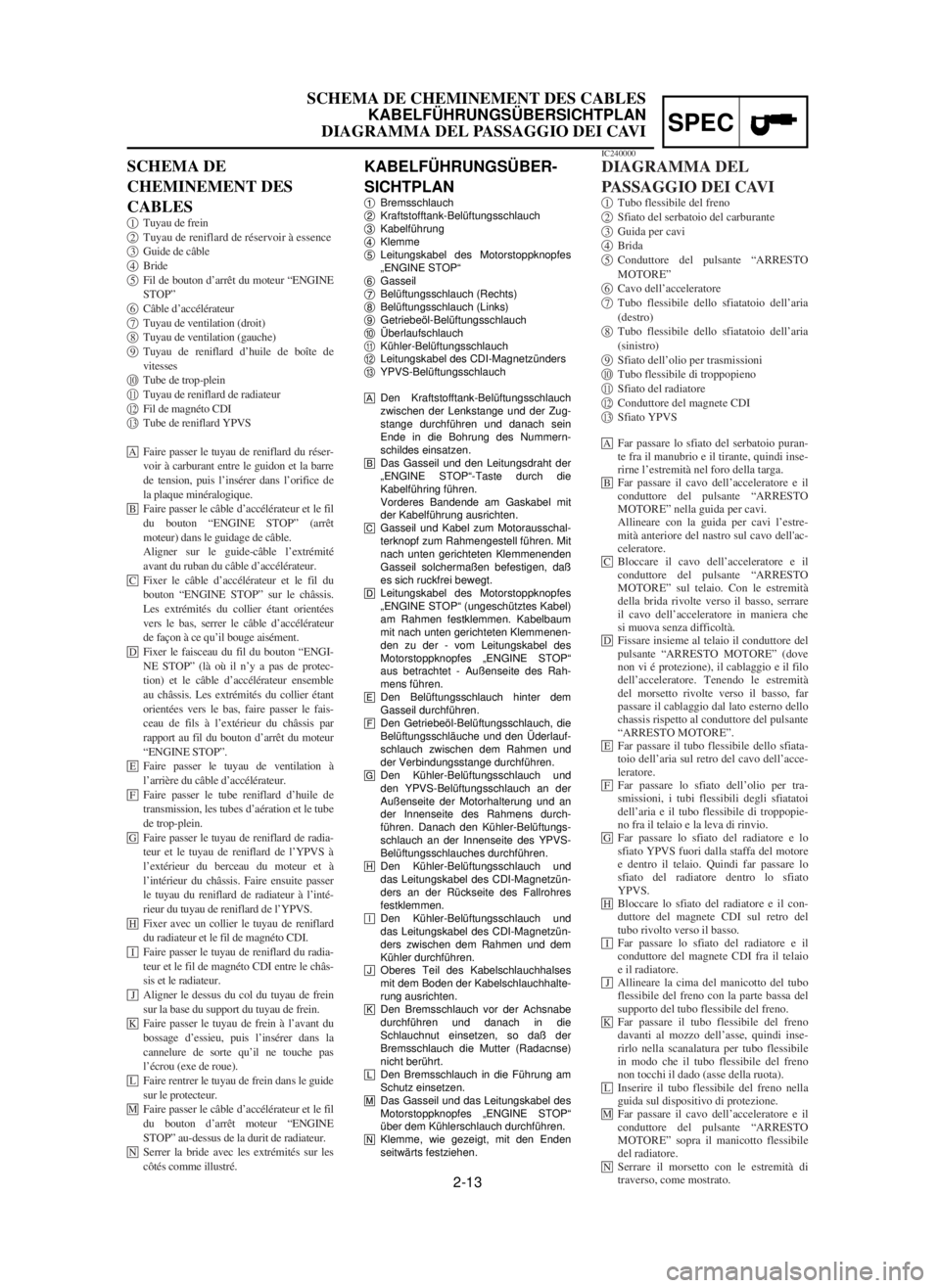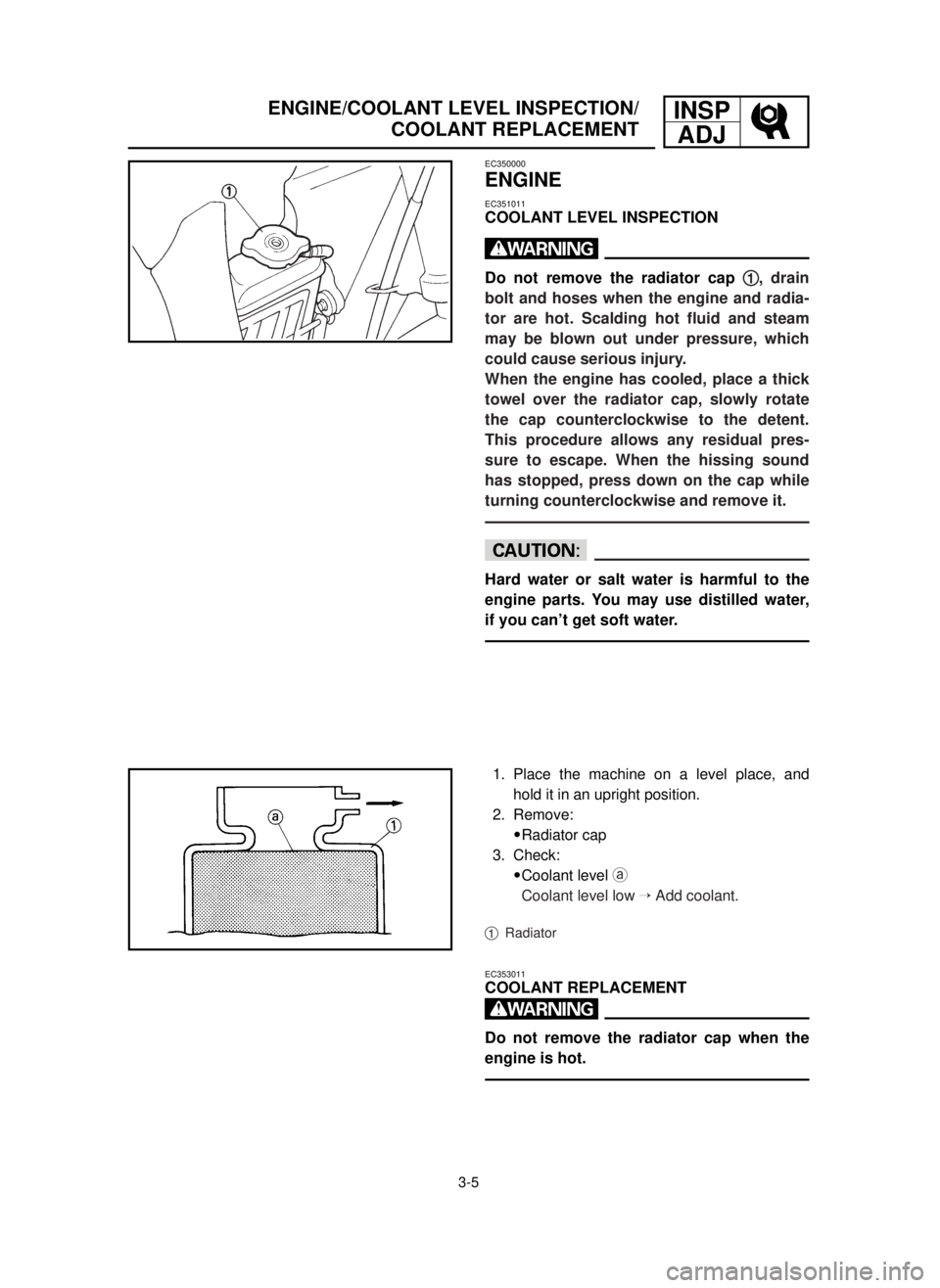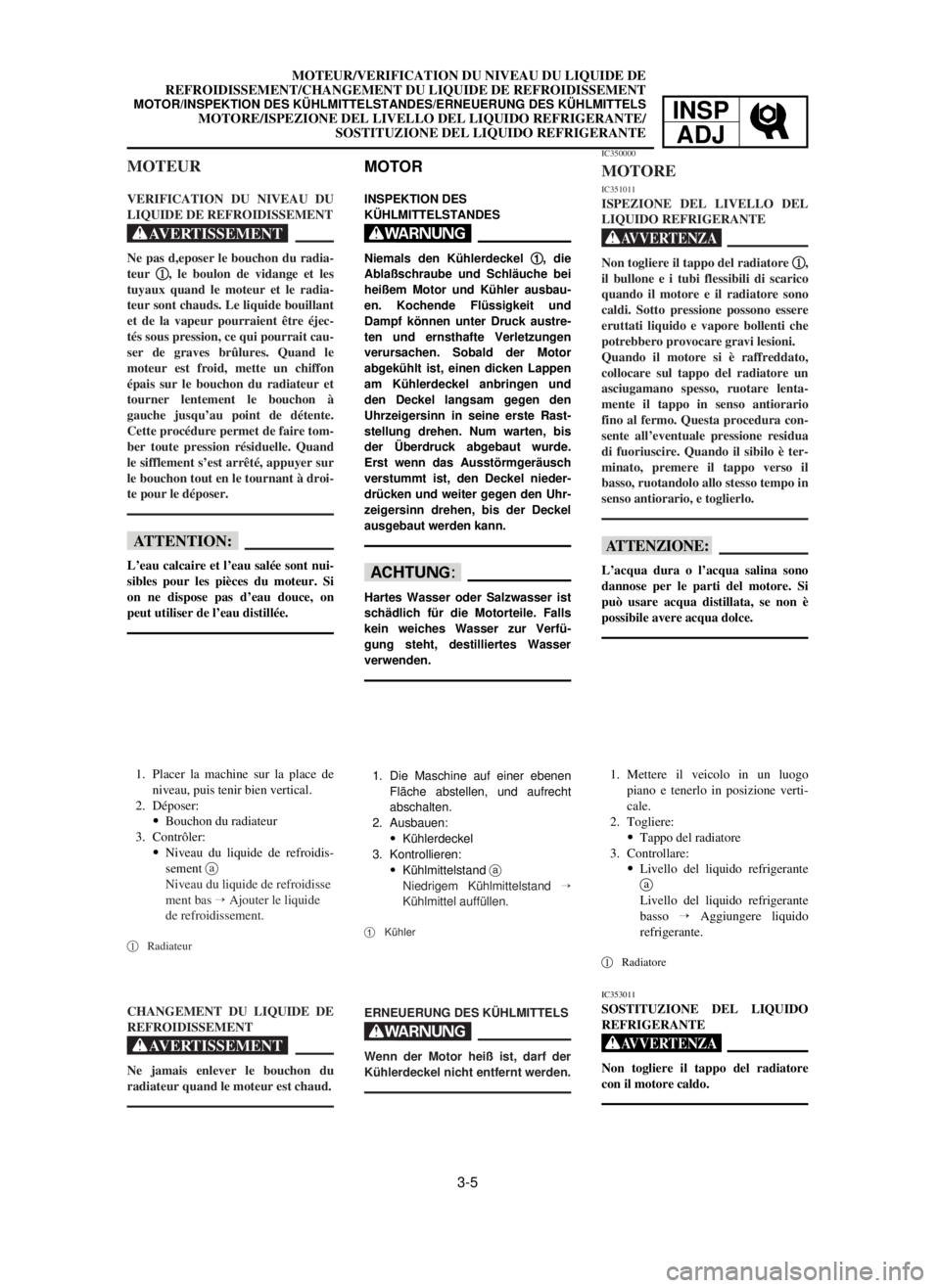radiator YAMAHA YZ125LC 2001 Betriebsanleitungen (in German)
[x] Cancel search | Manufacturer: YAMAHA, Model Year: 2001, Model line: YZ125LC, Model: YAMAHA YZ125LC 2001Pages: 558, PDF-Größe: 13.11 MB
Page 116 of 558

2-13
SPECCABLE ROUTING DIAGRAM
EC240000
1Brake hose
2Fuel tank breather hose
3Cable guide
4Clamp
5“ENGINE STOP” button lead
6Throttle cable
7Air vent hose (right)
8Air vent hose (left)
9Transmission oil breather
hose
0Overflow hose
qRadiator breather hose
wCDI magneto lead
eYPVS breather hose
APass the fuel tank breather
hose between the handlebar
and tension bar, then insert
its end into the hole of the
number plate.
BPass the throttle cable and
“ENGINE STOP” button lead
into the cable guide. Align
with the cable guide the
front end of the tape on the
throttle cable.CClamp the throttle cable and
“ENGINE STOP” button lead
to the frame. With the clamp
ends downward, tighten the
throttle cable to the extent
that it moves smoothly.
DClamp the “ENGINE STOP”
button lead (where there is
no protector), wireharness and
throttle cable all together to the
frame. With the clamp ends
downward, pass the
wireharness on the outer side
of the chassis in relation to the
“ENGINE STOP” button lead.
EPass the air vent hose at
the rear of the throttle cable.
FPass the transmission oil
breather hose, air vent hoses
and overflow hose between
the frame and connecting rod.
GPass the radiator breather
hose and YPVS breather hose
outside the engine bracket
and inside the frame. Then
pass the radiator breather hose inside the YPVS
breather hose.
HClamp the radiater breather
hose and CDI magneto lead
on the rear of the down-tube.
IPass the radiater breather
hose and CDI magneto
lead between the frame and
radiator.
JAlign the top of the brake hose
neck with the brake hose
holder bottom.
KPass the brake hose in front
of the axle boss, then fit it
into the hose groove so that
the brake hose does not
contact the nut (wheel axle).
LFit the brake hose into the
guide on the protector.
MPass the throttle cable and
“ENGINE STOP” button lead
over the radiator hose.
NTighten the clamp with its
ends sideways as shown.
5MV-9-30-2B 6/19/00 1:14 PM Page 26
Page 117 of 558

2-13
SPEC
SCHEMA DE CHEMINEMENT DES CABLES
KABELFÜHRUNGSÜBERSICHTPLAN
DIAGRAMMA DEL PASSAGGIO DEI CAVI
KABELFÜHRUNGSÜBER-
SICHTPLAN
1Bremsschlauch
2Kraftstofftank-Belüftungsschlauch
3Kabelführung
4Klemme
5Leitungskabel des Motorstoppknopfes
„ENGINE STOP“
6Gasseil
7Belüftungsschlauch (Rechts)
8Belüftungsschlauch (Links)
9Getriebeöl-Belüftungsschlauch
0Überlaufschlauch
qKühler-Belüftungsschlauch
wLeitungskabel des CDI-Magnetzünders
eYPVS-Belüftungsschlauch
ADen Kraftstofftank-Belüftungsschlauch
zwischen der Lenkstange und der Zug-
stange durchführen und danach sein
Ende in die Bohrung des Nummern-
schildes einsatzen.
BDas Gasseil und den Leitungsdraht der
„ENGINE STOP“-Taste durch die
Kabelführing führen.
Vorderes Bandende am Gaskabel mit
der Kabelführung ausrichten.
CGasseil und Kabel zum Motorausschal-
terknopf zum Rahmengestell führen. Mit
nach unten gerichteten Klemmenenden
Gasseil solchermaßen befestigen, daß
es sich ruckfrei bewegt.
DLeitungskabel des Motorstoppknopfes
„ENGINE STOP“ (ungeschütztes Kabel)
am Rahmen festklemmen. Kabelbaum
mit nach unten gerichteten Klemmenen-
den zu der - vom Leitungskabel des
Motorstoppknopfes „ENGINE STOP“
aus betrachtet - Außenseite des Rah-
mens führen.
EDen Belüftungsschlauch hinter dem
Gasseil durchführen.
FDen Getriebeöl-Belüftungsschlauch, die
Belüftungsschläuche und den Üderlauf-
schlauch zwischen dem Rahmen und
der Verbindungsstange durchführen.
GDen Kühler-Belüftungsschlauch und
den YPVS-Belüftungsschlauch an der
Außenseite der Motorhalterung und an
der Innenseite des Rahmens durch-
führen. Danach den Kühler-Belüftungs-
schlauch an der Innenseite des YPVS-
Belüftungsschlauches durchführen.
HDen Kühler-Belüftungsschlauch und
das Leitungskabel des CDI-Magnetzün-
ders an der Rückseite des Fallrohres
festklemmen.
IDen Kühler-Belüftungsschlauch und
das Leitungskabel des CDI-Magnetzün-
ders zwischen dem Rahmen und dem
Kühler durchführen.
JOberes Teil des Kabelschlauchhalses
mit dem Boden der Kabelschlauchhalte-
rung ausrichten.
KDen Bremsschlauch vor der Achsnabe
durchführen und danach in die
Schlauchnut einsetzen, so daß der
Bremsschlauch die Mutter (Radacnse)
nicht berührt.
LDen Bremsschlauch in die Führung am
Schutz einsetzen.
MDas Gasseil und das Leitungskabel des
Motorstoppknopfes „ENGINE STOP“
über dem Kühlerschlauch durchführen.
NKlemme, wie gezeigt, mit den Enden
seitwärts festziehen.
SCHEMA DE
CHEMINEMENT DES
CABLES
1Tuyau de frein
2Tuyau de reniflard de réservoir à essence
3Guide de câble
4Bride
5Fil de bouton d’arrêt du moteur “ENGINE
STOP”
6Câble d’accélérateur
7Tuyau de ventilation (droit)
8Tuyau de ventilation (gauche)
9Tuyau de reniflard d’huile de boîte de
vitesses
0Tube de trop-plein
qTuyau de reniflard de radiateur
wFil de magnéto CDI
eTube de reniflard YPVS
ŒFaire passer le tuyau de reniflard du réser-
voir à carburant entre le guidon et la barre
de tension, puis l’insérer dans l’orifice de
la plaque minéralogique.
ºFaire passer le câble d’accélérateur et le fil
du bouton “ENGINE STOP” (arrêt
moteur) dans le guidage de câble.
Aligner sur le guide-câble l’extrémité
avant du ruban du câble d’accélérateur.
Fixer le câble d’accélérateur et le fil du
bouton “ENGINE STOP” sur le châssis.
Les extrémités du collier étant orientées
vers le bas, serrer le câble d’accélérateur
de façon à ce qu’il bouge aisément.
¶Fixer le faisceau du fil du bouton “ENGI-
NE STOP” (là où il n’y a pas de protec-
tion) et le câble d’accélérateur ensemble
au châssis. Les extrémités du collier étant
orientées vers le bas, faire passer le fais-
ceau de fils à l’extérieur du châssis par
rapport au fil du bouton d’arrêt du moteur
“ENGINE STOP”.
«Faire passer le tuyau de ventilation à
l’arrière du câble d’accélérateur.
ÄFaire passer le tube reniflard d’huile de
transmission, les tubes d’aération et le tube
de trop-plein.
©Faire passer le tuyau de reniflard de radia-
teur et le tuyau de reniflard de l’YPVS à
l’extérieur du berceau du moteur et à
l’intérieur du châssis. Faire ensuite passer
le tuyau du reniflard de radiateur à l’inté-
rieur du tuyau de reniflard de l’YPVS.
úFixer avec un collier le tuyau de reniflard
du radiateur et le fil de magnéto CDI.
öFaire passer le tuyau de reniflard du radia-
teur et le fil de magnéto CDI entre le châs-
sis et le radiateur.
ÆAligner le dessus du col du tuyau de frein
sur la base du support du tuyau de frein.
ûFaire passer le tuyau de frein à l’avant du
bossage d’essieu, puis l’insérer dans la
cannelure de sorte qu’il ne touche pas
l’écrou (exe de roue).
ÂFaire rentrer le tuyau de frein dans le guide
sur le protecteur.
µFaire passer le câble d’accélérateur et le fil
du bouton d’arrêt moteur “ENGINE
STOP” au-dessus de la durit de radiateur.
÷Serrer la bride avec les extrémités sur les
côtés comme illustré.
IC240000
DIAGRAMMA DEL
PASSAGGIO DEI CAVI
1Tubo flessibile del freno
2Sfiato del serbatoio del carburante
3Guida per cavi
4Brida
5Conduttore del pulsante “ARRESTO
MOTORE”
6Cavo dell’acceleratore
7Tubo flessibile dello sfiatatoio dell’aria
(destro)
8Tubo flessibile dello sfiatatoio dell’aria
(sinistro)
9Sfiato dell’olio per trasmissioni
0Tubo flessibile di troppopieno
qSfiato del radiatore
wConduttore del magnete CDI
eSfiato YPVS
ŒFar passare lo sfiato del serbatoio puran-
te fra il manubrio e il tirante, quindi inse-
rirne l’estremità nel foro della targa.
ºFar passare il cavo dell’acceleratore e il
conduttore del pulsante “ARRESTO
MOTORE” nella guida per cavi.
Allineare con la guida per cavi l’estre-
mità anteriore del nastro sul cavo dell'ac-
celeratore.
Bloccare il cavo dell’acceleratore e il
conduttore del pulsante “ARRESTO
MOTORE” sul telaio. Con le estremità
della brida rivolte verso il basso, serrare
il cavo dell’acceleratore in maniera che
si muova senza difficoltà.
¶Fissare insieme al telaio il conduttore del
pulsante “ARRESTO MOTORE” (dove
non vi é protezione), il cablaggio e il filo
dell’acceleratore. Tenendo le estremità
del morsetto rivolte verso il basso, far
passare il cablaggio dal lato esterno dello
chassis rispetto al conduttore del pulsante
“ARRESTO MOTORE”.
«Far passare il tubo flessibile dello sfiata-
toio dell’aria sul retro del cavo dell’acce-
leratore.
ÄFar passare lo sfiato dell’olio per tra-
smissioni, i tubi flessibili degli sfiatatoi
dell’aria e il tubo flessibile di troppopie-
no fra il telaio e la leva di rinvio.
©Far passare lo sfiato del radiatore e lo
sfiato YPVS fuori dalla staffa del motore
e dentro il telaio. Quindi far passare lo
sfiato del radiatore dentro lo sfiato
YPVS.
úBloccare lo sfiato del radiatore e il con-
duttore del magnete CDI sul retro del
tubo rivolto verso il basso.
öFar passare lo sfiato del radiatore e il
conduttore del magnete CDI fra il telaio
e il radiatore.
ÆAllineare la cima del manicotto del tubo
flessibile del freno con la parte bassa del
supporto del tubo flessibile del freno.
ûFar passare il tubo flessibile del freno
davanti al mozzo dell’asse, quindi inse-
rirlo nella scanalatura per tubo flessibile
in modo che il tubo flessibile del freno
non tocchi il dado (asse della ruota).
ÂInserire il tubo flessibile del freno nella
guida sul dispositivo di protezione.
µFar passare il cavo dell’acceleratore e il
conduttore del pulsante “ARRESTO
MOTORE” sopra il manicotto flessibile
del radiatore.
÷Serrare il morsetto con le estremità di
traverso, come mostrato.
5MV-9-30-2B 6/19/00 1:14 PM Page 27
Page 118 of 558

2-14
SPECCABLE ROUTING DIAGRAM
1Brake hose holder
2Master cylinder
3Brake hose
4Hose guide
5CDI unit band
6CDI unit
7High tension cord
8Ignition coil
9Cable guide
0Radiator breather hose
qWireharness
w“ENGINE STOP” button lead
eCDI magneto lead
rClutch cable
tClamp
yCDI unit bracket
uEngine bracket
iCDI unit damper
APass the brake hose into
the brake hose holder.BIf the brake hose contacts
the spring (rear shock
absorber), correct its twist.
CInstall the brake hose so that
its pipe portion directs as
shown and lightly touches
the projection on the master
cylinder.
DPass the reservoir hose
between the brake hose and
swingarm bracket.
EPut the CDI unit fully in
the CDI unit band.
FFasten the ground lead
together with the ignition
coil.
GPass the cluch cable into
the cable guide.
HClamp the CDI magneto lead
on the upper part of
the frame gusset at its
protecting tube.IPass the clutch cable over
the radiator hose.
JClamp the wireharness on
the top of the CDI unit with
the clamp end downward.
KCut the clamp end to be flush
with CDI unit side.
LFit the CDI unit band over
the CDI unit bracket till it
stops.
MInstall the brake hose to
the caliper with the paint on
the pipe facing the caliper
and with the pipe contacting
the caliper projection.
NPass the radiator breather
hose between the frame and
radiator hose so that it is not
kinked or wedged.
OPosition the CDI unit between
the engine brackets as
shown.
5MV-9-30-2B 6/19/00 1:14 PM Page 28
Page 119 of 558

2-14
SPEC
SCHEMA DE CHEMINEMENT DES CABLES
KABELFÜHRUNGSÜBERSICHTPLAN
DIAGRAMMA DEL PASSAGGIO DEI CAVI
1Bremsschlauchhalter
2Hauptbremszylinder
3Bremsschlauch
4Schlauchführung
5Band der CDI-Einheit
6CDI-Einheit
7Hochspannungskabel
8Zündspule
9Kabelführung
0Kühler-Belüftungsschlauch
qKabelbaum
wLeitungskabel des Motorstoppknopfes
„ENGINE STOP“
eLeitungskabel des CDI-Magnetzünders
rKupplungskabel
tKlemme
yCDI-Halter
uMotorhalterung
iCDI-Einheitsdämpfer
ADen Bremsschlauch in den Brems-
schlauchhalter führen.
BFalls der Bremsschlauch die Feder
(Hinterrad-Stoßdämpfer) berührt, seine
Verdrehung berichtigen.
CDen Bremsschlauch so einbauen, daß
sein Rohrteil gemäß Abbildung ange-
ordnet ist und den Überstand am
Hauptbremszylinder leicht berührt.
DDen Ausgleichschlauch zwischen dem
Bremsschlauch und der Schwingenhal-
terung durchführen.
EDie CDI-Einheit vollständig in das Band
der CDI-Einheit einsetzen.
FDas Massekabel gemeinsam mit der
Zündspule befestigen.
GDas Kupplungskabel in die Kabel-
führung einführen.
HDas Leitungskabel des CDI-Magnetzün-
ders am oberen Teil der Rehmensfütze
an ihrem Schutzrohr festklemmen.
IDas Kupplungskabel über dem Kühler-
schlauch anordnen.
JKabelbaum mit nach unten gerichtetem
Klemmenende oben an der CDI fest-
klemmen.
KKlemmenende bündig mit der CDI-Seite
abschneiden.
LDas Band der CDI-Einheit bis zum
Anschlag über dem CDI-Halter führen.
M
Bremsschlauch so am Bremssattel
anbringen,daß die Farbe am Rohr
dem Bremssattel zugewendet ist und
das Rohr den Überstand des Brems-
sattels leicht berührt.
NKühlerentlüftungsschlauch zwischen
dem Rahmen und dem Kühlerschlauch
so führen, daß er weder geknickt noch
verklemmt wird.
OCDI-Einheit wie dargestellt zwischen
den Motorhalterungen anbringen.
1Support de tuyau de frein
2Maître-cylindre
3Tuyau de frein
4Guide de tuyau
5Bandeau du bloc CDI
6Bloc CDI
7Cordon de haute-tension
8Bobine d’allumage
9Guide de câble
0Tuyau de reniflard de radiateur
qFaisceau de fils
wFil de bouton d’arrêt du moteur “ENGI-
NE STOP”
eFil de magnéto CDI
rCâble d’embrayage
tBride
ySupport du bloc CDI.
uSupport du moteur
iAmortisseur du bloc CDI
ŒFaire passer le tuyau de frein dans les
pattes de support de tuyau de frein.
ºSi le tuyau de frein touche le ressort
(amortisseur arrière), ajuster le coude.
Installer le tuyau de frein de manière que
la partie avec le tuyau soit dirigée
comme indiqué et touche légèrement la
saillie sur le maître-cylindre.
¶Faire passer le tuyau de réserve entre le
tuyau de frein et le support du bras oscil-
lant.
«Mettre le bloc CDI entièrement dans le
bandeau de bloc CDI.
ÄFixer le fil de masse à la bobine d’allu-
mage.
©Faire passer le câble d’embrayage dans
le guide de câble.
úFixer le fil de magnéto de CDI sur la par-
tie supérieure du couvre-joint du tube de
protection.
öFaire passer le câble d’embrayage sur la
durite du radiateur.
ÆFixer le faisceau de fils au sommet du
bloc CDI avec l’extrémité du collier vers
le bas.
ûCouper l’extrémité du collier de façon à
l’aligner sur le bord du bloc CDI.
ÂAdapter complètement le bandeau du
bloc CDI sur le support du bloc CDI.
µInstaller le conduit de frein sur l’étrier en
veillant à ce que la marque peinte sur le
conduit soit orientée vers l’étrier et que
le conduit soit en contact avec la saillie
de l’étrier.
÷Faire passer le tuyau reniflard du radia-
teur entre le châssis et la durite du radia-
teur de façon à ce qu'il ne soit pas plié ni
coincé.
¿Positionner le bloc CDI entre les sup-
ports du moteur comme illustré.1Supporto del tubo flessibile del freno
2Cilindro principale
3Tubo flessibile del freno
4Guida per tubo flessibile
5Nastro dell’unità CDI
6Unità CDI
7Cavo ad alta tensione
8Bobina di accensione
9Guida per cavi
0Sfiato del radiatore
qComplesso conduttori
wConduttore del pulsante “ARRESTO
MOTORE”
eConduttore del magnete CDI
rCavo della frizione
tBrida
yStaffa dell’unità CDI
uStaffa del motore
iSmorzatore dell’unità CDI
ŒFar passare il tubo flessibile del freno nel
supporto del tubo flessibile del freno.
ºSe il tubo flessibile del freno tocca la
molla (ammortizzatore posteriore), cor-
reggerne la torsione.
Installare il tubo flessibile del freno in
maniera tale che la sua parte di tubo sia
rivolta come illustrato e tocchi legger-
mente la sporgenza sul cilindro principa-
le.
¶Far passare il tubo flessibile del serbatoio
fra il tubo flessibile del freno e la staffa
del forcellone oscillante.
«Collocare l’unità CDI completamente nel
nastro dell’unità CDI.
ÄFissare il filo di terra insieme alla bobina
di accensione.
©Far passare il cavo della frizione nella
guida per cavi.
úBloccare il conduttore del magnete CDI
sulla parte superiore del fazzoletto del
telaio in corrispondenza del suo tubo di
protezione.
öFar passare il cavo della frizione sopra il
manicotto flessibile del radiatore.
ÆBloccare il complesso conduttori sulla
parte superiore dell’unità CDI con
l’estremità della brida rivolta verso il
basso.
ûTagliare l’estremità della brida in modo
che sia a filo con il lato dell’unità CDI.
ÂInserire il nastro dell’unità CDI sopra il
puntello dell’unità CDI finché non si
arresta.
µInstallare il tubo flessibile del freno sulla
pinza mantenendo la vernice del tubo
rivolta verso la pinza, ed il tubo a contat-
to con la sporgenza della pinza.
÷Fare scorrere il tubo di sfiato del radiato-
re tra il telaio e il tubo del radiatore in
modo che non si attorcigli e non rimanga
schiacciato.
¿Posizione dell’unità CDI tra le staffe del
motore, come mostrato.
5MV-9-30-2B 6/19/00 1:14 PM Page 29
Page 123 of 558

3-2
MAINTENANCE INTERVALS
INSP
ADJ
Item Remarks
COOLING SYSTEM
Check coolant level and leakagell
Check radiator cap operationl
Replace coolantlEvery two years
Inspect hosesl
OUTSIDE NUTS AND BOLTS Refer to “STARTING
RetightenllAND BREAK-IN” section
in the CHAPTER 1.
AIR FILTER
Clean and lubricatellUse foam air-filter oil
Replacel
FRAME
Clean and inspectll
FUEL TANK, COCK
Clean and inspectll
BRAKES
Adjust lever position and pedal heightll
Lubricate pivot pointll
Check brake disc surfacell
Check fluid level and leakagell
Retighten brake disc bolts, caliper bolts,
ll
master cylinder bolts and union bolts
Replace padsl
Replace brake fluidlEvery one year
FRONT FORKS
Inspect and adjustll
Replace oilllSuspension oil “01”
Replace oil seall
FRONT FORK OIL SEAL AND DUST SEAL
Clean and lubellLithium base grease
REAR SHOCK ABSORBER
Inspect and adjustll
Lube ll
Molybdenum disulfide grease
Retightenll
CHAIN GUARD AND ROLLERS
Inspectll
SWINGARM
Inspect and retightenll
RELAY ARM, CONNECTING ROD
Inspect and lubellMolybdenum disulfide grease
STEERING HEAD
Inspect free play and retightenll
Clean and lubelLithium base grease
Replace bearingl
TIRE, WHEELS
Inspect air pressure, wheel run-out,
ll
tire wear and spoke looseness
Retighten sprocket boltll
Inspect bearingsl
Replace bearingsl
LubricatelLithium base grease
THROTTLE, CONTROL CABLE
Check routing and connectionllYamaha cable lube or
LubricatellSAE 10W-30 motor oil
After
break-
inEvery
raceEvery
thirdEvery
fifthAs re-
quired
3
5MV-9-30-3A 6/19/00 1:52 PM Page 3
Page 132 of 558

3-2
INTERVALLI DI MANUTENZIONE
INSP
ADJ
IMPIANTO DI RAFFREDDAMENTO
Controllo livello e perdite di liquido
66refrigerante
Controllo funzionamento del tappo
del radiatore
6
Sostituzione del liquido refrigerante6
Ispezione dei tubi flessibili6
DADI E VITI ESTERNI
Riserraggio
66
FILTRO DELL’ARIA
Pulitura e lubrificazione
66
Sostituzione6
TELAIO
Pulitura e ispezione
66
SERBATOIO, RUBINETTO DEL
CARBURANTE
Pulitura e ispezione
66
FRENI
Regolazione posizione della leva e
66altezza del pedale
Lubrificazione punto di snodo
66
Controllo superficie del disco del freno66
Controllo livello e perdite di liquido66
Riserraggio bulloni del disco del
freno, bulloni della pinza, bulloni del
66
cilindro principale e bulloni di unione
Sostituzione pastiglie
6
Sostituzione liquido per freni6
FORCELLE ANTERIORI
Ispezione e regolazione
66
Sostituzione dell’olio66
Sostituzione del paraolio6
PARAOLIO E PARAPOLVERE
DELLA FORCELLA ANTERIORE
Pulitura e lubrificazione
66
AMMORTIZZATORE POSTERIORE
Ispezione e regolazione
66
Lubrificazione 66
Riserraggio66
COPRICATENA E RULLI PER
CATENA
Ispezione
66
FORCELLONE OSCILLANTE
Ispezione e riserraggio
66
BRACCIO DI RINVIO, LEVA
DI RINVIO
Ispezione e lubrificazione
66
TESTA DI STERZO
Ispezione gioco libero e riserraggio
66
Pulitura e lubrificazione6
Sostituzione del cuscinetto6
Ogni due anni
Consultare la sezione
“AVVIAMENTO E
RODAGGIO” al CAPITOLO 1.
Usare olio per filtri dell’aria
in schiuma
Ogni anno
Olio per sospensioni “01”
Grasso a base di litio
Grasso a base di bisolfuro di
molibdeno
Grasso a base di bisolfuro di
molibdeno
Grasso a base di litio Dopo il Ogni OgniIn base
Voce
rodaggiogaraOgni
cinquealle Osservazioninecessità
5MV-9-30-3A 6/19/00 1:52 PM Page 12
Page 134 of 558

3-4
PRE-OPERATION INSPECTION AND MAINTENANCE
INSP
ADJ
EC320000
PRE-OPERATION INSPECTION AND MAINTENANCE
Before riding for break-in operation, practice or a race, make sure the machine is in good operating
condition.
Before using this machine, check the following points.
EC321000
GENERAL INSPECTION AND MAINTENANCE
Item Routine Page
Coolant Check that coolant is filled up to the radiator filler cap.
Check the cooling system for leakage.P3-5~9
Fuel Check that a fresh mixture of oil and gasoline is filled in
the fuel tank. Check the fuel line for leakage.P1-12
Transmission oil Check that the oil level is correct. Check the crankcase
for leakage.P3-12~14
Gear shifter and clutch Check that gears can be shifted correctly in order and
that the clutch operates smoothly.P3-9
Throttle grip/Housing Check that the throttle grip operation and free play
are correctly adjusted. Lubricate the throttle grip and P3-10~11
housing, if necessary.
Brakes Check the play of front brake and effect of front and
rear brake.P3-17~23
Chain Check chain slack and alignment. Check that the chain
is lubricated properly.P3-24~26
Wheels Check for excessive wear and tire pressure. Check for
loose spokes and have no excessive play.P3-34~35
Steering Check that the handlebar can be turned smoothly and
have no excessive play.P3-35~36
Front forks and Check that they operate smoothly and there is no oil
rear shock absorber leakage.P3-26~33
Cables (wires) Check that the clutch and throttle cables move smooth-
ly. Check that they are not caught when the handlebars —
are turned or when the front forks travel up and down.
Muffler Check that the muffler is tightly mounted and has no
cracks.P3-15~16
Sprocket Check that the driven sprocket tightening bolt is
not loose.P3-24
Lubrication Check for smooth operation. Lubricate if necessary. P3-37
Bolts and nuts Check the chassis and engine for loose bolts and nuts. P1-16
Lead connectors Check that the CDI magneto, CDI unit, and ignition coil
are connected tightly.P1-6
Settings Is the machine set suitably for the condition of the
racing course and weather or by taking into account the
P7-1~24
results of test runs before racing? Are inspection and
maintenance completely done?
5MV-9-30-3A 6/19/00 1:52 PM Page 14
Page 137 of 558

3-4
ISPEZIONE E MANUTENZIONE PRIMA DEL
INSP
ADJ
Voce Procedura Pagina
Controllare che il liquido refrigerante sia riempito fino al
tappo di riempimento del radiatore.Controllare
l’impianto di raffreddamento per eventuali perdite.
Controllare che il serbatoio del carburante sia riempito
con una miscela fresca di olio e benzina. Controllare il
tubo del carborante per eventuali perdite.
Controllare che il livello dell’olio sia corretto.
Controllare il carter per eventuali perdite.
Controllare che sia possibile cambiare correttamente le
marce in ordine e che la frizione funzioni senza strappi.
Controllare che il funzionamento e il gioco libero della
manopola dell’acceleratore siano regolati correî.
Lubrificare la manopola dell’acceleratore e la carcassa,
se necessario.
Controllare il gioco del freno anteriore e l’effetto del
freno anteriore e posteriore.
Controllare il gioco e l’allineamento della catena.
Controllare che la catena sia lubrificata adeguatamente.
Controllare l’usura eccessiva e la pressione degli
pneumatici. Controllare che le razze non siano allentate e
non abbiano un gioco eccessivo.
Controllare che il manubrio possa essere girato senza
strappi e non abbia un gioco eccessivo.
Controllare che funzionino senza problemi e che non vi
siano perdite d’olio.
Controllare che i cavi della frizione e dell’acceleratore si
muovano senza problemi. Controllare che non rimanga-
no impigliati quando viene girato il manubrio o quando
le forcelle anteriori si alzano e si abbassano.
Controllare che la marmitta sia montata saldamente e
non presenti incrinature.
Controllare che il bullone di serraggio del rocchetto
condotto non sia allentato.
Controllare il regolare funzionamento. Lubrificare se
necessario.
Controllare il telaio e il motore per eventuali viti e dadi
allentati.
Controllare che il magnete CDI, l’unità CDI e la bobina
di accensione siano collegati saldamente.
Il veicolo è impostato correttamente per le condizioni del
circuito di gara e atmosferiche o tenendo conto dei
risultati delle prove prima della gara? L’ispezione e la
manutenzione sono state effettuate in maniera completa?
Liquido refrigerante
Carburante
Olio per trasmissioni
Cambio e frizione
Manopola dell’acceleratore/
Carcassa
Freni
Catena
Ruote
Sterzo
Forcelle anteriori e
ammortizzatore posteriore
Cavi (fili)
Marmitta
Rocchetto
Lubrificazione
Viti e dadi
Connettori dei conduttori
ImpostazioniP3-5~9
P1-12
P3-12~14
P3-9
P3-10~11
P3-17~23
P3-24~26
P3-34~35
P3-35~36
P3-26~33
—
P3-15~16
P3-24
P3-37
P1-16
P1-6
P7-1~24
IC320000
ISPEZIONE E MANUTENZIONE PRIMA DEL FUNZIONAMENTO
Prima di usarlo per il rodaggio, per allenamento o per una gara, accertarsi che il veicolo sia in buone condi-
zioni di funzionamento.
Prima di usare questo veicolo, controllare i punti che seguono.
IC321000
ISPEZIONE E MANUTENZIONE GENERALI
5MV-9-30-3A 6/19/00 1:52 PM Page 17
Page 138 of 558

3-5
INSP
ADJENGINE/COOLANT LEVEL INSPECTION/
COOLANT REPLACEMENT
EC350000
ENGINE
EC351011
COOLANT LEVEL INSPECTION
w
Do not remove the radiator cap 1 1
, drain
bolt and hoses when the engine and radia-
tor are hot. Scalding hot fluid and steam
may be blown out under pressure, which
could cause serious injury.
When the engine has cooled, place a thick
towel over the radiator cap, slowly rotate
the cap counterclockwise to the detent.
This procedure allows any residual pres-
sure to escape. When the hissing sound
has stopped, press down on the cap while
turning counterclockwise and remove it.
cC
Hard water or salt water is harmful to the
engine parts. You may use distilled water,
if you can’t get soft water.
1. Place the machine on a level place, and
hold it in an upright position.
2. Remove:
9Radiator cap
3. Check:
9Coolant level a
Coolant level low ÕAdd coolant.
1Radiator
EC353011
COOLANT REPLACEMENT
w
Do not remove the radiator cap when the
engine is hot.
5MV-9-30-3A 6/19/00 1:52 PM Page 18
Page 139 of 558

3-5
MOTEUR/VERIFICATION DU NIVEAU DU LIQUIDE DE
REFROIDISSEMENT/CHANGEMENT DU LIQUIDE DE REFROIDISSEMENT
MOTOR/INSPEKTION DES KÜHLMITTELSTANDES/ERNEUERUNG DES KÜHLMITTELSMOTORE/ISPEZIONE DEL LIVELLO DEL LIQUIDO REFRIGERANTE/
SOSTITUZIONE DEL LIQUIDO REFRIGERANTEINSP
ADJ
MOTOR
INSPEKTION DES
KÜHLMITTELSTANDES
W
Niemals den Kühlerdeckel 1 1
, die
Ablaßschraube und Schläuche bei
heißem Motor und Kühler ausbau-
en. Kochende Flüssigkeit und
Dampf können unter Druck austre-
ten und ernsthafte Verletzungen
verursachen. Sobald der Motor
abgekühlt ist, einen dicken Lappen
am Kühlerdeckel anbringen und
den Deckel langsam gegen den
Uhrzeigersinn in seine erste Rast-
stellung drehen. Num warten, bis
der Überdruck abgebaut wurde.
Erst wenn das Ausstörmgeräusch
verstummt ist, den Deckel nieder-
drücken und weiter gegen den Uhr-
zeigersinn drehen, bis der Deckel
ausgebaut werden kann.
dD
Hartes Wasser oder Salzwasser ist
schädlich für die Motorteile. Falls
kein weiches Wasser zur Verfü-
gung steht, destilliertes Wasser
verwenden.
1. Die Maschine auf einer ebenen
Fläche abstellen, und aufrecht
abschalten.
2. Ausbauen:
9Kühlerdeckel
3. Kontrollieren:
9Kühlmittelstand a
Niedrigem Kühlmittelstand Õ
Kühlmittel auffüllen.
1Kühler
ERNEUERUNG DES KÜHLMITTELS
W
Wenn der Motor heiß ist, darf der
Kühlerdeckel nicht entfernt werden.
MOTEUR
VERIFICATION DU NIVEAU DU
LIQUIDE DE REFROIDISSEMENT
XG
Ne pas d,eposer le bouchon du radia-
teur 1 1
, le boulon de vidange et les
tuyaux quand le moteur et le radia-
teur sont chauds. Le liquide bouillant
et de la vapeur pourraient être éjec-
tés sous pression, ce qui pourrait cau-
ser de graves brûlures. Quand le
moteur est froid, mette un chiffon
épais sur le bouchon du radiateur et
tourner lentement le bouchon à
gauche jusqu’au point de détente.
Cette procédure permet de faire tom-
ber toute pression résiduelle. Quand
le sifflement s’est arrêté, appuyer sur
le bouchon tout en le tournant à droi-
te pour le déposer.
fF
L’eau calcaire et l’eau salée sont nui-
sibles pour les pièces du moteur. Si
on ne dispose pas d’eau douce, on
peut utiliser de l’eau distillée.
1. Placer la machine sur la place de
niveau, puis tenir bien vertical.
2. Déposer:
9Bouchon du radiateur
3. Contrôler:
9Niveau du liquide de refroidis-
sement a
Niveau du liquide de refroidisse
ment bas Õ Ajouter le liquide
de refroidissement.
1Radiateur
CHANGEMENT DU LIQUIDE DE
REFROIDISSEMENT
XG
Ne jamais enlever le bouchon du
radiateur quand le moteur est chaud.
IC350000
MOTORE
IC351011
ISPEZIONE DEL LIVELLO DEL
LIQUIDO REFRIGERANTE
T
Non togliere il tappo del radiatore 1 1
,
il bullone e i tubi flessibili di scarico
quando il motore e il radiatore sono
caldi. Sotto pressione possono essere
eruttati liquido e vapore bollenti che
potrebbero provocare gravi lesioni.
Quando il motore si è raffreddato,
collocare sul tappo del radiatore un
asciugamano spesso, ruotare lenta-
mente il tappo in senso antiorario
fino al fermo. Questa procedura con-
sente all’eventuale pressione residua
di fuoriuscire. Quando il sibilo è ter-
minato, premere il tappo verso il
basso, ruotandolo allo stesso tempo in
senso antiorario, e toglierlo.
iI
L’acqua dura o l’acqua salina sono
dannose per le parti del motore. Si
può usare acqua distillata, se non è
possibile avere acqua dolce.
1. Mettere il veicolo in un luogo
piano e tenerlo in posizione verti-
cale.
2. Togliere:
9Tappo del radiatore
3. Controllare:
9Livello del liquido refrigerante
a
Livello del liquido refrigerante
basso ÕAggiungere liquido
refrigerante.
1Radiatore
IC353011
SOSTITUZIONE DEL LIQUIDO
REFRIGERANTE
T
Non togliere il tappo del radiatore
con il motore caldo.
5MV-9-30-3A 6/19/00 1:52 PM Page 19